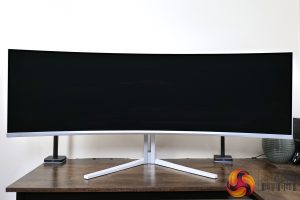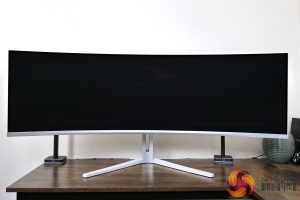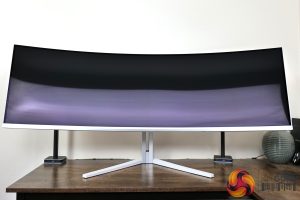The Philips Evnia 49M2C8900 shares the same design language as the 34M2C8600 we reviewed last year, meaning we have an eye-catching white and silver aesthetic that certainly stands out compared to the all-black screens we are used to seeing. Whether or not its to your taste is another matter, but Evnia is certainly doing things a little differently in the design departments. Philips Ambiglow lighting is also supported, with LEDs along the top and sides of the monitor which can be customised using the OSD.
We also have to mention the sheer size of the thing, as the 32:9 aspect ratio over a 49in panel means the whole monitor is almost 1.2m across – it's full dimensions, including the stand at maximum height, come in at 1195 x 544 x 359 mm, so you will definitely want a large desk for this one! It does also curve slightly, with an 1800R radius, but that's fairly subtle at this screen size.
Overall ergonomic adjustments are reasonable considering the size, too. We get height adjust up to 120mm, 20 degrees of swivel both left and right, as well as tilt from -5 to +15 degrees. There's understandably no pivot functionality here, but VESA 100×100 mounts are also supported via a small adapter bracket.
Round the back, in the bottom right corner, a small joystick can be used to navigate the OSD. Alternatively, and more conveniently I'd say, a remote control also comes bundled.
As for display inputs and connectivity, it is pleasing to the see the 49M2C8900 comes well-stocked in this department. We get two HDMI 2.1 ports for instance, along with a DisplayPort 1.4 and USB-C port that supports DP-Alt mode and 90W power delivery. There's also a four-port USB 3.2 Gen1 hub, two of which support fast charging, along with an audio jack, plus a total of four 7.5W speakers which deliver a surprisingly full sound.
 KitGuru KitGuru.net – Tech News | Hardware News | Hardware Reviews | IOS | Mobile | Gaming | Graphics Cards
KitGuru KitGuru.net – Tech News | Hardware News | Hardware Reviews | IOS | Mobile | Gaming | Graphics Cards















